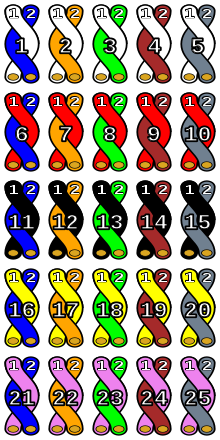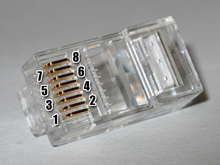TIA-568A / B
EIA / TIA 568A and EIA / TIA-568B are standards for contacting eight-pole RJ-45 - plugs and sockets . They were defined by the three organizations Electronic Industries Alliance (EIA), Telecommunications Industry Association (TIA) and International Telecommunications Union (ITU). Both standards are used in computer networks ( LAN ) on Ethernet (10BASE-T, 100BASE-TX and 1000BASE-T) and in many digital telephone systems , with EIA / TIA-568B being used more often.
The two variants are due to the fact that EIA / TIA introduced the TIA-568A standard much later than the company AT&T introduced the proprietary standard 258A. By the time TIA-568A was released, 258A was already widely used. EIA / TIA therefore adopted this established standard as TIA-568B.
Pairing and color
A cable consists of eight individual wires . The eight wires are grouped by twisting two wires to form four wire pairs . Twisting the wires is intended to reduce crosstalk to neighboring wire pairs. The pairs must be used as such. If a cable is wired incorrectly, so that two wires of different pairs are used as one wire pair, errors in the computer network can be expected. In telephony this is noticeable as noise or crosstalk from other telephone calls .
The wire pairs are colored according to the first four entries of the 25-pair color code table from AT&T, which are derived from the wiring of the 50-pin (25-pair) RJ-21 connector. The first wire is colored according to the primary color. There is also a line of the secondary color. The second wire is colored with the secondary color and also with a line of the primary color. Depending on the manufacturer, the lines on the wires can also run transversely or be omitted entirely.
The primary color of the first four entries is white . The secondary color of the 1st entry is blue , the 2nd is orange , the 3rd is green and the 4th entry is brown . It should be noted that the color assignment to the contacts can be different depending on the standard.
wiring
Regardless of the standard actually used, the contacts of RJ-45 plugs and sockets are numbered:

RJ-45 connector. Front view of the connector. Latch above, contacts below.
|
Pin 1 of the plug contacts pin 1 of the socket. According to the standard used, the contacts are wired as follows:
The only difference between TIA-568A and TIA-568B is the interchanging of wire pairs 2 and 3 (orange and green). Both standards wire the contacts "straight through". This means that contact 1 on one side is connected to contact 1 on the other side and that this is maintained for all eight contacts. In this case it does not matter whether the patch cables according to TIA-568A or TIA-568B are connected, as they are wired 1: 1.
When cabling networks, it is usually determined in advance whether TIA-568A or TIA-568B will be used and then implemented uniformly. In Europe, wiring is generally carried out according to TIA-568A, as this assignment corresponds to the general color codes of telephone installations. For historical reasons, however, TIA-568B is still quite common in the USA, but TIA-568A is usually also used there for new systems.
If you connect a TIA-568A connector and the other TIA-568B connector to a LAN cable , you get a crossover cable . The crossover cable is useful as a patch cable for point-to-point connections between two computers or two hubs / switches with 100BASE-TX or 10BASE-T. Newer 100BASE-T and practically all 1000BASE-T devices support Auto MDI-X , with which the crossing is made automatically by the device ( network adapter , switch, etc.) if necessary .
literature
- Christoph Meinel, Harald Sack: Internetworking. Technical basics and applications. Springer-Verlag, Berlin / Heidelberg 2012, ISBN 978-3-540-92940-6 .
- Joseph Robert Liberto: Answering The Call . I Universe, Lincoln 2004, ISBN 0-595-32385-5 .
- Techrepublic Staff: Small Office Networking . CNET Networks, 1995, ISBN 1-931490-71-6 .
- Michael E. Whitman, Herbert J. Mattord, David Mackey, Andrew Green: Guide to Network Security . Cengage Learning, Boston 2013, ISBN 978-0-8400-2422-0 .
- Markus Kammermann: CompTIA Network +. Prepare for Exam N10-006. 6th edition. mitp Verlag, Sigloch 2015, ISBN 978-3-95845-192-6 .
See also
- Cable sharing , use of unused wires for a further connection
- Twisted pair cable
- Hirose Electric



